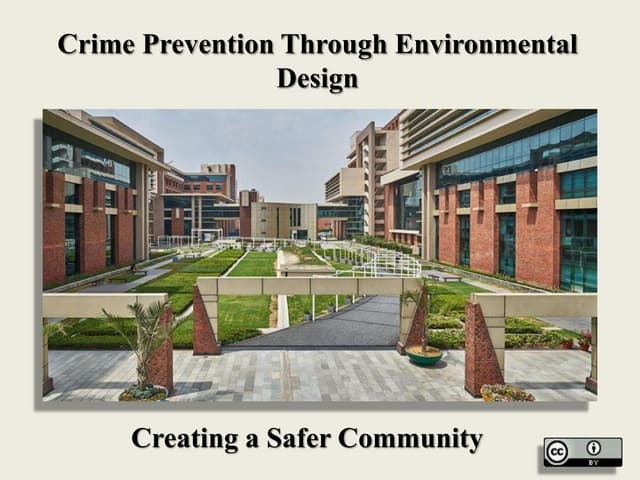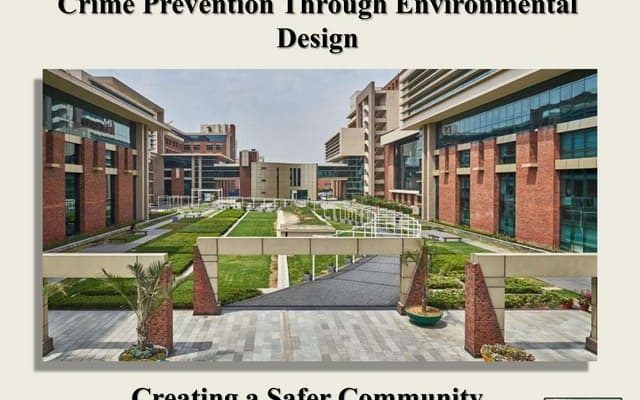Introduction
Urban Crime Prevention Through Environmental Design (CPTED) is a multidisciplinary approach to deterring criminal behavior through environmental design. This concept focuses on the idea that the proper design and effective use of the built environment can lead to a reduction in the incidence and fear of crime, thereby improving the quality of life.
CPTED strategies rely on the ability to influence offender decisions that precede criminal acts by affecting the built, social, and administrative environment.

Principles of CPTED
CPTED is based on several key principles:
- Natural Surveillance: The concept of natural surveillance is based on the principle that criminal activities are less likely to occur if they can be easily observed. This can be achieved by designing landscapes that allow clear sightlines, placing windows and doors to promote visibility, and ensuring adequate lighting.
- Natural Access Control: This principle focuses on using design elements to guide the flow of people and reduce opportunities for crime. It includes strategies such as installing physical barriers (fences, gates), designing walkways and roads to funnel movement, and strategically placing entry points to control access to certain areas.
- Territorial Reinforcement: By clearly delineating private and public spaces, territorial reinforcement helps to create a sense of ownership and responsibility among residents and users. This can be achieved through the use of physical designs such as fencing, signage, landscaping, and pavement treatments that convey ownership.
- Maintenance and Management: Proper maintenance and management of the built environment are crucial for CPTED. A well-maintained area tends to attract law-abiding citizens and repel potential offenders. This includes regular upkeep of buildings, prompt repair of damages, and ensuring that public spaces are clean and well-lit.
Applications of CPTED in Urban Areas
CPTED principles can be applied in various urban settings to enhance safety and reduce crime:
- Residential Areas: In residential neighborhoods, CPTED strategies can include designing homes with front porches to encourage interaction among neighbors, ensuring clear sightlines from homes to the street, and using landscaping to define private spaces.
- Commercial Areas: In commercial districts, effective CPTED measures might involve using transparent storefronts to increase natural surveillance, designing parking lots with clear visibility, and placing public amenities like benches and trash cans in areas with high pedestrian traffic.
- Public Spaces: Parks, plazas, and other public spaces can benefit from CPTED by incorporating open and inviting designs, providing adequate lighting, and ensuring that these areas are actively used throughout the day and night to deter criminal behavior.
- Transportation Hubs: Bus stops, train stations, and other transportation hubs can enhance safety by using design elements such as clear sightlines, proper lighting, and signage to guide movement and control access.
Challenges and Considerations
While CPTED offers a proactive approach to crime prevention, there are several challenges and considerations to keep in mind:
- Community Involvement: Successful implementation of CPTED requires active involvement from the community. Engaging residents, business owners, and other stakeholders in the planning process is crucial for ensuring that the design meets their needs and fosters a sense of ownership.
- Balancing Security and Accessibility: There is a delicate balance between enhancing security and maintaining accessibility. Overly restrictive designs can create a fortress-like environment that may deter legitimate users as well as potential offenders.
- Cultural Sensitivity: CPTED strategies must be culturally sensitive and appropriate for the specific community. What works in one area may not be effective or acceptable in another, so it is essential to consider the unique social and cultural context.
- Cost and Resources: Implementing CPTED can require significant investment in terms of time, money, and resources. Ensuring that there are adequate funds and support for ongoing maintenance and management is critical for the long-term success of CPTED initiatives.
Conclusion
Urban Crime Prevention Through Environmental Design (CPTED) offers a strategic approach to reducing crime and enhancing the quality of life in urban areas. By focusing on natural surveillance, access control, territorial reinforcement, and maintenance, CPTED aims to create environments that discourage criminal behavior and promote a sense of safety and community. However, successful implementation requires community involvement, a balance between security and accessibility, cultural sensitivity, and adequate resources. When thoughtfully applied, CPTED can significantly contribute to the development of safer, more vibrant urban spaces.




